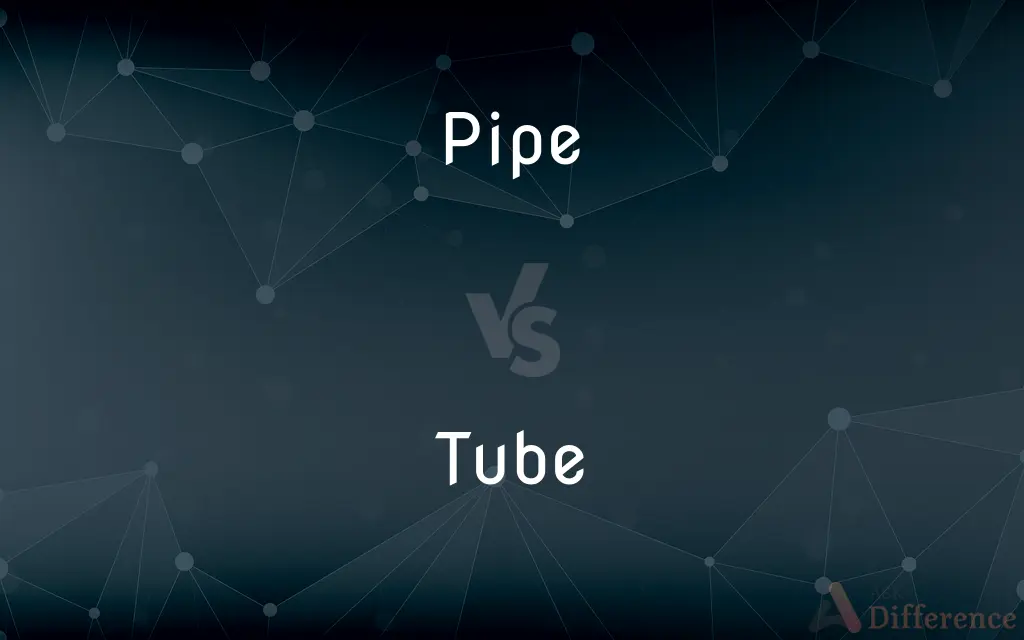Pipe vs. Tube — What's the Difference?
By Tayyaba Rehman & Fiza Rafique — Published on March 30, 2024
Pipe is measured in terms of internal diameter and used primarily for transporting fluids and gases, whereas tube is measured by its external diameter and finds applications in structural and aesthetic contexts.

Difference Between Pipe and Tube
Table of Contents
ADVERTISEMENT
Key Differences
A pipe is characterized by its function of transporting fluids and gases, which necessitates consideration of its internal diameter (ID) for flow rate and pressure calculations. On the other hand, a tube is often chosen for structural or aesthetic purposes, with its size specified by the external diameter (OD), affecting its strength and appearance in applications.
Pipes are typically available in standard sizes and are made from materials like steel, copper, and plastic, tailored for fluid transport. Tubes, whereas, come in a wider variety of materials, including brass, aluminum, and steel, catering to both functional and decorative needs in industries ranging from automotive to construction.
The wall thickness of a pipe is standardized according to schedules, which define its pressure rating and are crucial for ensuring safe fluid transport. Conversely, tube wall thickness is not standardized in the same way, allowing for a broader selection to suit the specific strength and bending requirements of each project.
Pipes use nominal sizing, a system that is not directly related to the actual dimensions but rather to a performance standard, making it easier for industry professionals to specify and install without detailed measurements. Tubes, on the other hand, are specified by their actual dimensions, requiring more precision in selection and use.
In terms of connections, pipes are often joined using methods like welding, threading, or flanges, designed to ensure a leak-proof system for fluids. Tubes, whereas, may be connected by welding or by using special fittings designed for structural integrity, allowing for more flexibility in design and assembly.
ADVERTISEMENT
Comparison Chart
Primary Use
Transporting fluids and gases
Structural and aesthetic uses
Size Measurement
Internal Diameter (ID)
External Diameter (OD)
Materials
Steel, copper, plastic
Brass, aluminum, steel
Wall Thickness
Standardized (schedules)
Varied, not standardized
Sizing System
Nominal, unrelated to actual dimensions
Specified by actual dimensions
Connection Methods
Welding, threading, flanges
Welding, special fittings
Compare with Definitions
Pipe
A pipe is a hollow cylinder for transporting fluids.
The water supply to the house is facilitated by a series of pipes.
Tube
A tube is a cylindrical object used in structural applications.
The frame of the bike is made from lightweight titanium tubes.
Pipe
The wall thickness of pipes is important for their pressure rating.
High-pressure systems require pipes with thicker walls.
Tube
Tubes are measured by their external diameter.
The handrail is constructed with 1.5-inch OD tubes.
Pipe
Pipe systems often include fittings for direction changes.
We installed elbow fittings to route the pipes around obstacles.
Tube
The choice of tube material varies by application.
Aluminum tubes are preferred for their strength-to-weight ratio.
Pipe
Pipes are categorized by their nominal size.
We replaced the old 2-inch pipes with larger ones to improve flow.
Tube
Tubes can have various wall thicknesses for different needs.
Thin-walled tubes bend easily for curved designs.
Pipe
Pipes can be made from various materials depending on their use.
The gas lines are made of high-strength steel pipes.
Tube
Structural tubes are often joined by welding.
The tubes in the structure were welded at the joints for added strength.
Pipe
A hollow cylinder or tube used to conduct a liquid, gas, or finely divided solid.
Tube
A hollow cylinder, especially one that conveys a fluid or functions as a passage.
Pipe
A section or piece of such a tube.
Tube
An organic structure having the shape or function of a tube; a duct
A bronchial tube.
Pipe
A large wine cask, especially one having a capacity of 126 gallons or 2 hogsheads (478 liters).
Tube
A small flexible cylindrical container sealed at one end and having a screw cap at the other, for pigments, toothpaste, or other pastelike substances.
Pipe
A rigid tube that transports water, steam, or other fluid, as used in plumbing and numerous other applications.
Tube
(Music) The cylindrical part of a wind instrument.
Pipe
The contents of such a vessel, as a liquid measure, sometimes set at 126 wine gallons; half a tun.
Tube
An approximately cylindrical container, usually with a crimped end and a screw top, used to contain and dispense semiliquid substances.
A tube of toothpaste.
Pipe
A passageway for the air in speaking and breathing; the windpipe, or one of its divisions.
Tube
A more or less cylindrical, and often spiral, case secreted or constructed by many annelids, crustaceans, insects, and other animals, for protection or concealment. See Illust. of Tubeworm.
Pipe
A long tube made of metal or plastic that is used to carry water or oil or gas etc.
Tube
Conduit consisting of a long hollow object (usually cylindrical) used to hold and conduct objects or liquids or gases
Common Curiosities
What materials are pipes made from?
Pipes are made from materials like steel, copper, and plastic.
What is the main difference between pipe and tube?
The main difference lies in their use; pipes are for fluid transport, while tubes are for structural purposes.
Are tube dimensions standardized?
Tube dimensions are specified by their actual external diameter and wall thickness, not standardized like pipes.
What are some common applications of tubes?
Common applications include structural frames, handrails, and automotive parts.
What factors influence the choice of material for pipes?
Factors include the type of fluid being transported, pressure requirements, and environmental conditions.
What is nominal pipe size?
Nominal pipe size is a standardized sizing system unrelated to the actual dimensions of the pipe, used for specifying pipe sizes.
How is pipe size determined?
Pipe size is determined by its internal diameter and nominal sizing system.
How is the wall thickness of pipes standardized?
The wall thickness of pipes is standardized according to schedules that define their pressure rating.
Can tubes be used for fluid transport?
Yes, tubes can be used for fluid transport, especially when precise dimensions or aesthetic appearance is important.
How are pipes connected in a system?
Pipes are connected using methods like welding, threading, or flanges.
Can the wall thickness of a tube affect its strength?
Yes, the wall thickness of a tube directly affects its strength and ability to withstand pressure or mechanical stress.
How does the external diameter of a tube affect its application?
The external diameter affects the tube's fit, strength, and appearance in its intended application.
Why might someone choose a pipe over a tube (or vice versa) for a particular project?
The choice depends on the project's needs: fluid transport and pressure requirements favor pipes, while structural integrity and aesthetics favor tubes.
Why are tubes preferred in some structural applications?
Tubes are preferred for their strength, flexibility in design, and aesthetic appearance.
What is the significance of a pipe's schedule number?
A pipe's schedule number indicates its wall thickness and thus its pressure rating and strength.
Share Your Discovery

Previous Comparison
Commercial Law vs. Corporate Law
Next Comparison
Calcium Carbonate vs. Calcium CitrateAuthor Spotlight
Written by
Tayyaba RehmanTayyaba Rehman is a distinguished writer, currently serving as a primary contributor to askdifference.com. As a researcher in semantics and etymology, Tayyaba's passion for the complexity of languages and their distinctions has found a perfect home on the platform. Tayyaba delves into the intricacies of language, distinguishing between commonly confused words and phrases, thereby providing clarity for readers worldwide.
Co-written by
Fiza RafiqueFiza Rafique is a skilled content writer at AskDifference.com, where she meticulously refines and enhances written pieces. Drawing from her vast editorial expertise, Fiza ensures clarity, accuracy, and precision in every article. Passionate about language, she continually seeks to elevate the quality of content for readers worldwide.














































